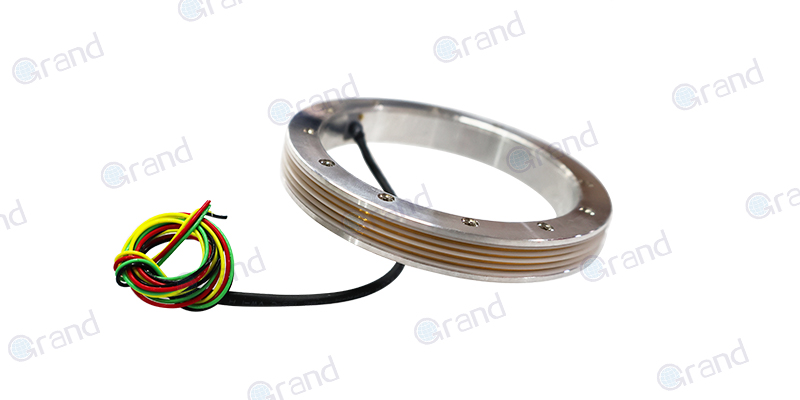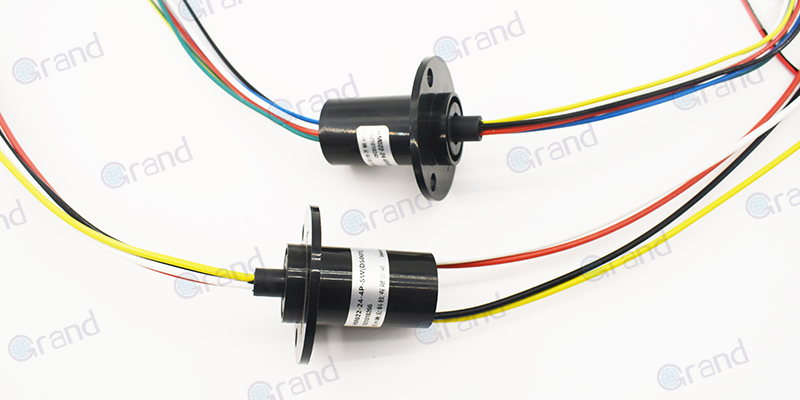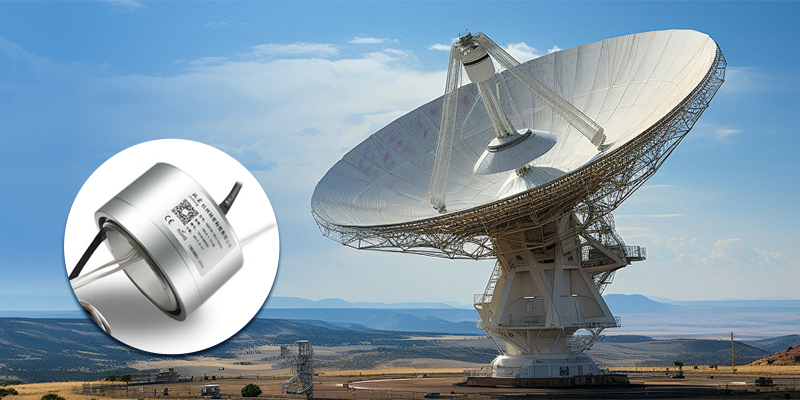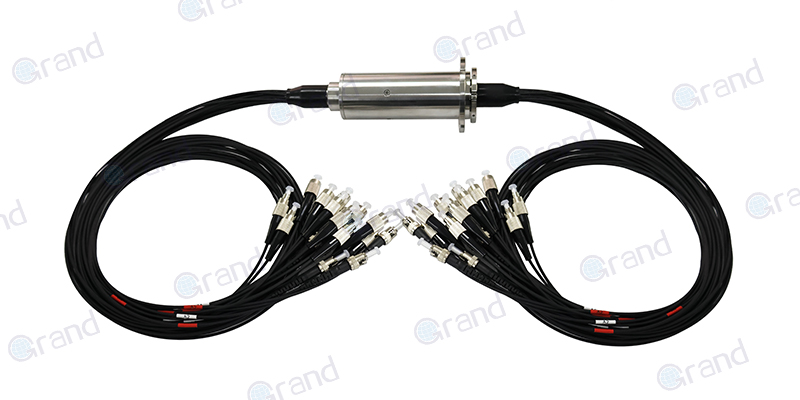Slip rings are electromechanical devices that transmit power, signals, or data between stationary and rotating systems, enabling continuous rotation in applications like wind turbines, robotics, and industrial machinery. However, at extreme speeds such as 25,000 RPM, standard slip rings face unique challenges that demand specialized engineering.
High-speed rotation generates intense heat due to friction and electrical resistance, risking material degradation, signal distortion, or catastrophic failure. Simultaneously, centrifugal forces at 25,000 RPM can deform components, destabilize electrical contacts, and accelerate wear. These factors compound over time, shortening the slip ring’s lifecycle if not properly addressed. Applications like aerospace actuators, high-speed motors in CNC machines, surgical robots, and drone gimbals exemplify scenarios where reliability at 25,000 RPM is non-negotiable. For instance, in aerospace, a slip ring failure could disrupt critical satellite mechanisms, while in medical robotics, precision and longevity are vital for uninterrupted surgeries.
Selecting a slip ring for such environments requires a focus on advanced cooling strategies, high-performance materials, and rigorous lifecycle testing to ensure stability under relentless mechanical and thermal stress. This article explores how to navigate these challenges, balancing performance, durability, and cost for high-RPM applications.
Key Challenges at 25,000 RPM
Thermal Management
At 25,000 RPM, heat generation becomes a critical bottleneck. Friction between rotating contacts (e.g., brushes and rings) and electrical resistance in circuits generate significant heat. Without proper dissipation, temperatures can exceed 150–200°C, leading to:
Material Degradation: Polymer insulators (e.g., PTFE) may soften or warp, while metal contacts oxidize, increasing resistance.
Signal Noise: Heat-induced expansion misaligns contacts, causing intermittent signal loss or electromagnetic interference (EMI).
Premature Failure: Sustained high temperatures accelerate wear, shortening the slip ring’s lifespan.
Active cooling (e.g., liquid-cooled housings) or advanced thermal interface materials (e.g., graphene-enhanced composites) are often required to maintain operational stability.
Mechanical Stress
Centrifugal forces at 25,000 RPM subject slip rings to extreme mechanical loads:
Deformation and Imbalance: Lightweight components like thin-walled rotors or plastic carriers can deform, causing imbalance and vibration. Even micron-level distortions disrupt contact alignment.
Vibration-Induced Instability: High-frequency vibrations loosen fasteners, misalign brushes, and create micro-arcing, degrading electrical performance.
To mitigate this, slip rings must use high-strength materials (e.g., titanium alloys, carbon-fiber-reinforced polymers) and precision-balanced designs. Finite Element Analysis (FEA) is critical for simulating stress distribution during development.
Electrical Performance
Electrical reliability erodes rapidly at ultra-high speeds:
Signal Integrity Issues:
Noise: EMI from arcing contacts or high-frequency switching disrupts sensitive signals (e.g., Ethernet, analog sensors).
Voltage Drop: Increased contact resistance from heat or vibration reduces power transmission efficiency.
Contact Resistance Variability:
Centrifugal forces push brushes away from rings, creating intermittent gaps.
Oxidation or debris buildup on contacts further destabilizes resistance.
Solutions include low-resistance precious metal coatings (e.g., gold-plated contacts for stable conductivity) and shielded cabling to minimize EMI.
Interconnected Risks
These challenges are not isolated. For example, heat from poor thermal management weakens structural materials, exacerbating centrifugal deformation. Similarly, vibration-induced contact gaps increase electrical resistance, generating more heat—a dangerous feedback loop. Thus, a holistic design approach is essential to address all three factors simultaneously.

Critical Selection Criteria
Cooling Solutions
Passive Cooling
Mechanism: Relies on natural heat dissipation through heat sinks, thermally conductive materials (e.g., aluminum alloys, copper), or radiative cooling.
Pros:
Low maintenance (no moving parts).
Compact and cost-effective for moderate heat loads.
Cons:
Limited effectiveness in high-power or continuous-duty scenarios.
Risk of overheating in sealed or high-ambient-temperature environments.
Best For: Applications with intermittent operation or low heat generation (e.g., small robotics, low-power sensors).
Active Cooling
Liquid Cooling: Circulates coolant (e.g., water-glycol, dielectric fluids) through channels in the slip ring housing.
Pros: High heat removal capacity; ideal for sustained 25,000 RPM operation.
Cons: Adds complexity, weight, and cost; requires pumps and seals.
Forced Air Cooling: Uses fans or compressed air to direct airflow over hot spots.
Pros: Simpler than liquid systems; effective in open environments.
Cons: Limited efficiency in dusty or humid conditions; noise concerns.
Best For: High-power industrial motors, aerospace systems.
Hybrid Approaches
Combines passive and active methods (e.g., heat sinks with integrated coolant channels or thermoelectric coolers).
Advantages: Balances efficiency and simplicity; extends operational life in variable-load scenarios.
Example: A slip ring with a copper heat sink paired with a low-power fan for peak heat dissipation.
Material Considerations
Contact Materials
Gold: Excellent conductivity and corrosion resistance, but soft and prone to wear. Ideal for low-current signal transmission.
Silver: Higher conductivity than gold, but oxidizes easily; often used with protective coatings.
Copper Alloys: Cost-effective and durable, but require plating (e.g., rhodium, nickel) to prevent oxidation.
Coatings:
Rhodium: Enhances hardness and arc resistance for high-speed slip rings sliding contacts.
Graphite: Reduces friction and wear in high-load environments.
Structural Materials
Metals (Aluminum, Stainless Steel): High strength and thermal conductivity, but heavier and prone to thermal expansion.
Composites (Carbon Fiber, Ceramic-Reinforced Polymers): Lightweight, low thermal expansion, and vibration-dampening, but costly and harder to machine.
Key Trade-off: Aluminum suits high heat dissipation needs, while composites excel in weight-sensitive aerospace applications.
Insulation Materials
PEEK (Polyether Ether Ketone): Withstands temperatures up to 250°C, excellent mechanical strength.
PTFE (Teflon): Superior chemical and heat resistance (260°C), but softer and less dimensionally stable.
Ceramic Coatings: Used in extreme environments to isolate high-voltage circuits.
Lifecycle and Durability
Wear Testing and Lifespan Prediction
Accelerated Testing: Simulates years of 25,000 RPM operation in weeks using elevated temperatures, loads, and RPMs.
Predictive Models: Analyze contact wear rates (e.g., µm/hour) and lubrication degradation to estimate maintenance intervals.
Sealing and Contamination Resistance
IP Ratings: IP67/IP68 seals prevent dust and moisture ingress, critical for medical or marine environments.
Lubrication:
Dry Lubricants: Reduce friction without attracting debris.
Greases: Provide long-term protection but require reapplication.
Modular vs. Integrated Designs
Modular Slip Rings: Allow replacement of worn contacts or brushes without disassembling the entire unit, reducing downtime.
Integrated Designs: Offer compactness and lower initial cost but may require full replacement upon failure.
Hybrid Solutions: Some designs feature replaceable brush cartridges within a sealed housing.
Key Takeaways
Cooling: Match cooling methods to heat load and duty cycle.
Materials: Prioritize conductivity, wear resistance, and thermal stability based on application demands.
Lifecycle: Design for repairability and contamination control to minimize total cost of ownership.
This section provides actionable insights for balancing performance, durability, and cost in high-RPM slip ring selection. Let me know if you need further details or examples!

Step-by-Step Selection Guide
Define Application Requirements
Begin by clearly outlining the operational parameters of your system:
RPM Range: Confirm that the slip ring is rated for continuous operation at 25,000 RPM, not just peak speeds. High RPMs amplify heat and mechanical stress, so verify torque tolerance to prevent rotor deformation.
Power/Signal Types:
Power Transmission: Specify voltage, current, and whether high-frequency noise (e.g., from motors) could interfere.
Data Signals: For Ethernet, fiber optics, or analog sensors, ensure the slip ring supports required bandwidth and EMI shielding.
Environmental Conditions:
Temperature extremes, humidity, dust, or chemical exposure dictate material choices (e.g., stainless steel for corrosion resistance).
Hazardous environments (e.g., explosive atmospheres) may require ATEX-certified designs.
Prioritize Cooling Needs
Select a cooling strategy aligned with your application’s duty cycle and environment:
Duty Cycle:
Continuous Operation: Active cooling (e.g., liquid systems) is essential to manage sustained heat.
Intermittent Use: Passive cooling (heat sinks) may suffice if rest periods allow heat dissipation.
Ambient Temperature:
In high-temperature settings (e.g., near engines), High-Temperature Slip Ring and hybrid cooling (passive + forced air) prevents overheating.
For compact spaces (e.g., surgical robots), prioritize low-profile active cooling solutions.
Material Compatibility Analysis
Balance performance and cost by evaluating material trade-offs:
Contact Materials:
Gold: Ideal for low-noise signal transmission but unsuitable for high-wear, high-current applications.
Silver-Copper Alloys: Cost-effective for power transmission but require rhodium plating to resist oxidation.
Structural Materials:
Aluminum: Lightweight and thermally conductive but prone to deformation under centrifugal force.
Titanium Composites: Higher strength-to-weight ratio for aerospace but expensive.
Insulation: Use PEEK for high-temperature stability or PTFE for chemical resistance.
Lifecycle Cost Evaluation
Avoid focusing solely on upfront costs—consider long-term expenses:
Maintenance Costs: Modular designs allow easy brush/contact replacement, reducing downtime.
Downtime Impact: In manufacturing, a 5,000slipringcausing10,000/hour in downtime justifies investing in a more reliable $8,000 unit.
Replacement Intervals: Compare vendor-predicted lifespans (e.g., 50 million rotations vs. 20 million) against application demands.
Vendor Evaluation
Assess suppliers rigorously to ensure quality and reliability:
Certifications:
MIL-STD-810: Validates durability in extreme conditions (vibration, thermal shock).
ISO 9001: Indicates consistent manufacturing quality.
Testing Data: Request RPM-specific test reports, including heat dissipation metrics and contact wear rates.
Industry Reputation:
Seek vendors with proven success in your sector (e.g., Grand Slip Ring in aerospace and medical).
Review case studies or customer testimonials for high-RPM applications.
Case Studies/Examples
Aerospace Application: Liquid-Cooled Slip Ring for Satellite Mechanisms
Challenge:
Satellite mechanisms, such as solar array drives or antenna positioning systems, require slip rings that operate reliably in the vacuum of space, where temperatures swing between extreme cold and intense solar heat. Traditional cooling methods (e.g., convection) fail in zero-atmosphere conditions, risking overheating at 25,000 RPM.
Solution:
A liquid-cooled slip ring was developed using:
Cooling: A closed-loop liquid system with dielectric coolant circulating through microchannels in the rotor, dissipating heat efficiently without relying on air.
Materials: Titanium housings for lightweight strength and low thermal expansion, paired with gold-graphite contacts to minimize friction and oxidation.
Lifecycle: Rigorous testing under simulated space conditions (thermal cycling, radiation exposure) ensured a 15-year operational lifespan.
Outcome:
The design enabled uninterrupted data transmission and power delivery for a geostationary satellite’s solar array, reducing mission downtime and eliminating mechanical failures due to thermal stress.

Medical Device: Compact, High-RPM Slip Ring with Passive Cooling in Surgical Robots
Challenge:
Surgical robots demand slip rings that fit within sterilizable, compact housings while delivering precise motion control at 25,000 RPM. Passive cooling was critical to avoid bulky active systems that could interfere with the robot’s agility.
Solution:
A miniaturized slip ring incorporated:
Cooling: Copper-aluminum heat sinks integrated into the rotor, leveraging the robot’s intermittent duty cycle to dissipate heat during idle periods.
Materials: Biocompatible PEEK insulation to withstand autoclave sterilization and gold-plated contacts for noise-free signal transmission.
Lifecycle: Redundant contact paths and modular brush cartridges allowed quick replacements without disassembling the robot.
Outcome:
The slip ring enhanced the precision of a laparoscopic surgical robot, achieving zero downtime over 5,000 procedures and complying with ISO 13485 medical device standards.
Industrial Motors: Long-Life Slip Rings Using Hybrid Cooling in CNC Machinery
Challenge:
CNC spindle motors operating continuously at 25,000 RPM generate significant heat and vibration, leading to frequent slip ring failures in high-duty-cycle environments.
Solution:
A hybrid-cooled slip ring was engineered with:
Cooling: Aluminum heat sinks paired with a low-profile forced-air system activated during peak loads.
Materials: Silver-nickel alloy contacts for high current capacity and carbon-fiber-reinforced rotors to resist centrifugal deformation.
Lifecycle: IP67-rated sealing prevented coolant ingress, while graphite lubrication extended brush life to 50 million rotations.
Outcome:
Deployed in a high-precision CNC milling machine, the slip ring reduced maintenance intervals by 60% and increased machine uptime by 30%, meeting ISO 9001 reliability benchmarks.
Common Mistakes to Avoid
Underestimating Thermal Management Needs
The Mistake: Assuming passive cooling or standard materials can handle the heat generated at 25,000 RPM.
Why It Happens: Engineers often extrapolate from lower-RPM applications, overlooking how friction and electrical resistance scale exponentially with speed. For example, a slip ring operating at 10,000 RPM might generate 50°C of heat, but at 25,000 RPM, this can surge to 150°C+ due to squared relationships in power loss (P = I²R).
Consequences:
Material Failure: Polymer insulators (e.g., PTFE) soften, causing short circuits.
Signal Degradation: Thermal expansion misaligns contacts, increasing noise or voltage drop.
Catastrophic Failure: Overheated components seize or warp, halting rotation.
How to Avoid:Conduct thermal simulations early in design.
Use active cooling (liquid systems) for continuous duty cycles.
Monitor temperature with embedded sensors in prototypes.
Case Example: A drone gimbal manufacturer initially used aluminum heat sinks for a 25,000 RPM slip ring but experienced melting contacts during extended flights. Switching to a liquid-cooled design resolved overheating.
Choosing Materials Solely for Conductivity Without Wear Analysis
The Mistake: Prioritizing high-conductivity metals like silver or copper without evaluating wear resistance at high speeds.
Why It Happens: Conductivity is often seen as the primary metric for electrical performance, but in high-RPM environments, mechanical wear dominates failure modes.
Consequences:
Rapid Contact Erosion: Silver contacts oxidize and wear down within hours, increasing resistance and heat.
Debris Generation: Worn particles contaminate the slip ring, causing arcing or short circuits.
How to Avoid:Use composite materials (e.g., gold-graphite contacts) that balance conductivity and durability.
Apply wear-resistant coatings (e.g., rhodium, diamond-like carbon) to sliding surfaces.
Conduct tribological testing to measure wear rates (e.g., µm per 1,000 hours).
Case Example: An industrial motor manufacturer selected pure copper brushes for high current capacity but faced weekly replacements due to rapid wear. Switching to copper-rhodium alloy contacts extended lifespan by 300%.
Ignoring Vibration and Imbalance in Lifecycle Testing
The Mistake: Overlooking dynamic mechanical stresses in testing protocols, leading to field failures.
Why It Happens: Traditional lifecycle tests often focus on electrical performance under static conditions, neglecting real-world vibration and rotational imbalance.
Consequences:
Contact Bounce: Vibration causes intermittent disconnection, corrupting data signals.
Component Fatigue: Imbalance accelerates bearing wear or rotor cracking.
How to Avoid:Simulate high-RPM vibration profiles (e.g., MIL-STD-810G Method 514.6) in testing.
Use precision balancing (e.g., ISO 1940 G2.5 standard) for rotors.
Incorporate dampening materials (e.g., elastomeric mounts) to absorb shocks.
Case Example: A robotics integrator skipped vibration testing for a 25,000 RPM slip ring, only to discover micro-cracks in the rotor after 100 hours. Post-failure analysis revealed resonant frequencies exceeding design limits.
FAQs about Select a Slip Ring for 25,000 RPM Applications
Q: How do I balance budget constraints with performance at 25,000 RPM?
Balancing cost and performance requires strategic prioritization:
Focus on Critical Components: Invest in high-performance contact materials (e.g., gold-plated or rhodium-coated contacts) to minimize wear and signal loss, even if they cost more upfront. Cheaper alternatives may fail prematurely, increasing lifecycle costs.
Optimize Cooling Solutions: Use passive cooling (heat sinks) for intermittent-duty applications to save costs, reserving active cooling (liquid systems) for continuous high-load scenarios.
Modular Designs: Choose slip rings with replaceable brushes or contacts to reduce long-term maintenance costs.
Lifecycle Cost Analysis: A slightly pricier slip ring with a 50,000-hour lifespan may be cheaper over time than a low-cost unit requiring frequent replacements.
Example: A factory using CNC machinery saved 20% in annual costs by opting for a hybrid-cooled slip ring with silver-nickel contacts instead of repeatedly replacing cheaper copper-based units.
Q: Can standard slip rings be modified for high-RPM use?
While minor upgrades are possible, most standard slip rings lack the foundational design for 25,000 RPM demands:
Modification Limits:
Materials: Standard contacts (e.g., copper) may oxidize or wear rapidly; upgrading to hardened alloys or coatings (e.g., graphite-rhodium) can help but may not fully resolve heat issues.
Cooling: Adding heat sinks or fans might mitigate heat, but airflow in enclosed systems is often insufficient.
Structural Reinforcements: Reinforcing rotors with carbon fiber sleeves can reduce deformation, but imbalance risks remain.
When to Avoid Modifications: For mission-critical applications (e.g., aerospace, medical), custom-designed slip rings are safer. Retrofits often lack certifications and may void warranties.
Example: A robotics firm attempted to modify a standard slip ring by adding forced-air cooling, but vibration-induced contact misalignment caused erratic data transmission. A purpose-built unit resolved the issue.
Q: What certifications are critical for reliability?
Certifications validate a slip ring’s ability to endure high-RPM stresses:
ISO 9001: Ensures consistent manufacturing quality and traceability.
MIL-STD-810: Certifies performance under extreme conditions (e.g., vibration, thermal shock), critical for aerospace/defense.
IP67/IP68: Guarantees dust/water resistance for harsh environments (e.g., marine, industrial).
ATEX/IECEx: Required for explosive atmospheres (e.g., oil and gas).
ISO 13485: Mandatory for medical devices, ensuring biocompatibility and sterilization compliance.
Why They Matter: Certifications like MIL-STD-810 involve rigorous RPM-specific testing (e.g., 25,000 RPM for 1,000+ hours), validating heat dissipation, wear rates, and contact stability. Non-certified units risk undetected design flaws.
Example: A satellite manufacturer avoided a costly mission failure by selecting a slip ring with MIL-STD-810 certification, which had already passed vacuum and thermal cycling tests.
See What We Can Do

